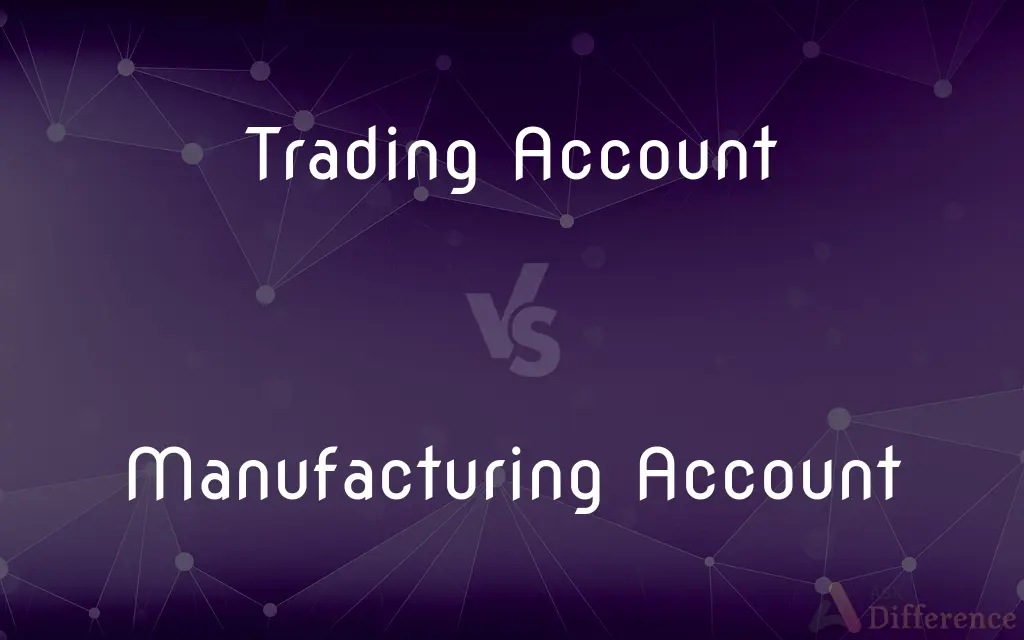Trading Account vs. Manufacturing Account — What's the Difference?
By Tayyaba Rehman — Published on October 27, 2023
A Trading Account showcases the gross profit or loss from sales, while a Manufacturing Account tallies the cost of goods produced in a manufacturing business.

Difference Between Trading Account and Manufacturing Account
Table of Contents
ADVERTISEMENT
Key Differences
A Trading Account is a statement that details the trading results of a business, illustrating the path to gross profit. It lists the opening stock, purchases, direct expenses, sales, and closing stock, to compute gross profit or loss. Conversely, a Manufacturing Account is specific to manufacturing businesses. It demonstrates the cost structure involved in producing goods, including raw materials, labor, and overheads.
Trading Accounts are essential for businesses that buy and sell goods, capturing the core financial dynamics of trading activities. Whether a company is in retail, wholesale, or trading, it relies on this account to determine its gross profitability. The Manufacturing Account, on the other hand, is tailored to entities that produce goods. It breaks down the various costs associated with production, offering clarity on production efficiency and cost management.
While the Trading Account stops at determining the gross profit or loss, it doesn’t delve into the intricacies of production costs. The Manufacturing Account fills this gap for manufacturers, showcasing the transition from raw materials to finished goods cost. It highlights material costs, wages, and other manufacturing overheads, providing a detailed view of production economics.
The significance of these accounts is in their usage. A Trading Account informs decisions related to sales, purchasing, and inventory management. In contrast, a Manufacturing Account aids in understanding the production process better, assisting managers in optimizing resources, controlling costs, and enhancing production efficiency.
Comparison Chart
Purpose
Determine gross profit/loss
Calculate cost of goods produced
ADVERTISEMENT
Components
Sales, Purchases, Opening/Closing Stock, Direct Expenses
Raw Materials, Labor Costs, Manufacturing Overheads
Business Type
Retail, Wholesale, Trading
Manufacturing
Level of Detail
Sticks to trading-related figures
Delves deep into production costs
Decision-making Utility
Sales, Purchase, Inventory Decisions
Production optimization, Cost control, Resource allocation
Compare with Definitions
Trading Account
Statement showing gross profit or loss.
The Trading Account revealed a substantial gross profit this quarter.
Manufacturing Account
Overview of costs in manufacturing goods.
Their Manufacturing Account highlighted efficient resource utilization.
Trading Account
Gauge of the direct profitability of trading activities.
The Trading Account’s insights prompted a change in their sales approach.
Manufacturing Account
Gauge of a company's manufacturing economics.
Regular reviews of the Manufacturing Account improved their production methodology.
Trading Account
Summary of trading activities for a period.
By examining the Trading Account, we could adjust our purchasing strategy.
Manufacturing Account
Breakdown of raw materials, labor, and overheads.
By analyzing the Manufacturing Account, we planned better for overhead costs.
Trading Account
Reflects a company's direct trading results.
Higher sales volume boosted the figures in the Trading Account.
Manufacturing Account
Statement detailing production costs.
The Manufacturing Account helped us identify areas for cost-cutting in production.
Trading Account
Account detailing sales and direct costs.
Their Trading Account indicated a need to reduce inventory levels.
Manufacturing Account
Reflects production efficiency and cost structure.
The Manufacturing Account unveiled potential areas of waste in the production line.
Common Curiosities
What does a Manufacturing Account depict?
A Manufacturing Account details the costs involved in producing goods in a manufacturing business.
What insights can a Trading Account provide?
It can inform decisions related to sales strategies, purchasing patterns, and inventory management.
Is a Manufacturing Account only for manufacturing businesses?
Yes, a Manufacturing Account is specifically tailored for manufacturing entities.
Why is a Manufacturing Account essential for production managers?
It assists in understanding production economics, optimizing resources, and enhancing efficiency.
What is the primary purpose of a Trading Account?
A Trading Account is used to determine the gross profit or loss from trading activities.
How does a Manufacturing Account aid in cost management?
It offers a detailed view of production costs, highlighting areas for optimization and cost control.
Does a Trading Account show net profit?
No, it shows gross profit. Net profit is determined after considering indirect expenses.
Can a company have both a Trading and Manufacturing Account?
Yes, manufacturing businesses often maintain both to understand production costs and gross profitability.
Are indirect expenses included in a Trading Account?
No, a Trading Account typically includes only direct expenses.
Do service businesses need a Trading Account?
Typically no, as they don't deal in goods, but they have an income statement to reflect earnings and expenses.
How often are these accounts typically prepared?
They are usually prepared annually, but businesses might do it quarterly or monthly for internal analysis.
How do these accounts aid in financial analysis?
They provide detailed insights into trading and production activities, crucial for performance evaluation and decision-making.
Are wages included in a Trading Account?
Only if they are direct wages related to trading. Production wages would appear in the Manufacturing Account.
What is the significance of manufacturing overheads in a Manufacturing Account?
Overheads give insights into fixed and variable production costs that aren't raw materials or direct labor.
Are these accounts mandatory for businesses?
It depends on local regulations, but even if not mandatory, they're highly beneficial for internal business analysis.
Share Your Discovery

Previous Comparison
Acetone vs. Lacquer Thinner
Next Comparison
Time Series vs. Panel DataAuthor Spotlight
Written by
Tayyaba RehmanTayyaba Rehman is a distinguished writer, currently serving as a primary contributor to askdifference.com. As a researcher in semantics and etymology, Tayyaba's passion for the complexity of languages and their distinctions has found a perfect home on the platform. Tayyaba delves into the intricacies of language, distinguishing between commonly confused words and phrases, thereby providing clarity for readers worldwide.
















































